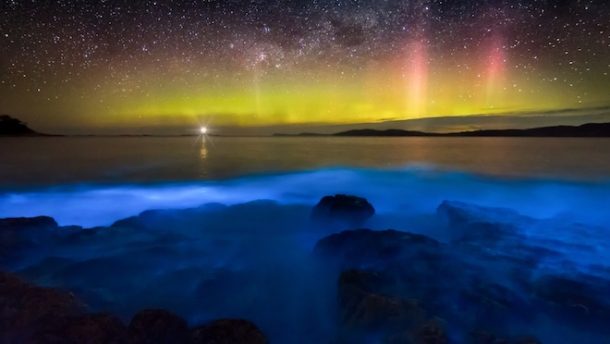Kiev. Ukraine. Ukraine Gate – January 18, 2021 – Science
Water near the shores of seas and oceans sometimes begins to glow at night. In some cases, this phenomenon is so beautiful that it seems that the coast has turned into a starry sky. People noticed this phenomenon for a very long time and scientists already know its cause. The fact is that a huge number of microbes live in the waters of the seas and oceans, and some possess bioluminescence. This is the name for the ability of living organisms to emit light. You can see the so-called glow of the sea in any corner of our planet – the main thing is that it is dark around and there are luminous organisms in the water. But in the future, our descendants may not see this beauty, because animals risk losing their amazing ability. Scientists conducted a study and found out.
Glowing animals
The ability to glow is possessed by different types of living organisms. The light appears in special luminous organs. For example, angler fish live at great depths, which attract prey with the help of a hanging “flashlight”. The organs of light in fish are called photophores. In insects, light is generated in special cells as a result of chemical processes. And bacteria glow due to the processes taking place in the cytoplasm – the semi-liquid content of cells.
As a rule, on the shores of seas and oceans, the glow is created by plankton. This is the name for tiny living organisms and plants that live in water and move exclusively by the force of the current. In their case, the glow is the result of physical and chemical processes. During movement, plankton, as it were, rubs against the water, which causes an electric discharge. It is he who forms the glow inside the cells of organisms. If you throw a stone into glowing water, friction will increase and a flash will occur. As mentioned above, this unusual phenomenon can be observed anywhere on our planet. In Russia, this beauty can be seen off the shores of the Okhotsk and Black seas.
Researchers distinguish three types of glow of the seas and oceans. The first is called sparkling glow and is due to organisms less than 5 millimeters in size. The second type is characterized by outbreaks – they arise as a result of the activity of large plankton like small crustaceans more than 1 centimeter. The third option is called uniform glow, which is due to bacteria living in the water. The uniform glow is the dimmest and can only be noticed in very dark environments.
The danger of global warming
But in the future, the creatures that glow today may lose their amazing ability. Researchers from the American state of Hawaii noticed that more and more carbon dioxide is being dissolved in the waters of the seas and oceans due to the observed global warming. This leads to acidification, which can severely harm aquatic life. It has been previously proven that such water leads to the destruction of shark scales and weakening of the shells of crabs. It was also found that due to global warming, some fish have enlarged genitals and they cannot reproduce.

As part of scientific work, the researchers decided to find out how oxidized water affects 49 bioluminescent creatures. Among them were bacteria, arthropods and other animal species. In the laboratory, they were all placed in water, the properties of which correspond to the forecasts for the year 2100. As a result, it turned out that under the new conditions, some species of squid significantly reduced the brightness of the glow. But some of the crustaceans, on the contrary, became a little brighter. This means that global warming will affect even these creatures and in the future, the “glowing seas” may disappear.
If animals lose their ability to glow, they can become completely extinct. The fact is that they need a glow not to entertain people, but to attract individuals of the opposite sex. If males cease to interest females and vice versa, they will cease to reproduce. In general, in the future, living creatures will have a hard time. But they are also threatened by another danger in the form of plastic waste. Bottles and packaging lying at the bottom of the seas and oceans do not decompose for 1000 years and literally poison animals. And humanity has not yet figured out how to solve this problem.







